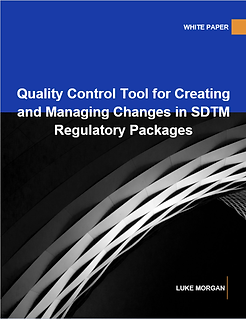Past Projects
Quality Control Tool for Creating and Managing Changes in SDTM Regulatory Packages
2022 - Master's Project in Healthcare Informatics


When creating and updating Standard Data Tabulation Model (SDTM) Define Packages, it can be inconvenient, timely, and easy to overlook certain aspects which can lead to errors (Hufford et al., 2017). To provide better quality control, we developed a SAS program that helps to minimize manual review. Our Define Compare Program is an excellent tool to be used in conjunction with Pinnacle 21 Enterprise (P21E) to effectively and timely create and update SDTM Define Packages while minimizing the effort of manual review. This saves a significant amount of time and provides additional supportive documentation. We will show the need for the program, the principles behind the program, and the results of the program. We expect this program to have the capability to reduce the time needed to create a Define Package by up to 66%.
Utilizing Questionnaires to Measure Quality of Life in Patients with DMD
2021 - Evidence-Based Healthcare Methods
Duchenne muscular dystrophy (DMD) is a rare genetic disease “characterized by progressive muscle degeneration and weakness” that generally affects male children (Muscular Dystrophy Association). DMD is a severe and debilitating disease where limited treatment options exist (Bushby et al., 2010). DMD is studied with the hopes of developing effective treatment and disease management techniques. To help measure the effectiveness of DMD treatments, questionnaires are utilized to help measure changes in quality of life. However, there is a lack of standardization in the questionnaires used in DMD studies.
Our interest is to help facilitate the standardization of a questionnaire to fully measure the overall health of patients with DMD before and after treatment is administered. We created a case study to show that the results of such a survey can be analyzed to measure changes in quality of life. We hope this work will pique interest in the field to help develop one clinically recommended standard survey to effectively measure the quality of life in patients with DMD.

Case Study Analysis: Implementing a Telemedicine Solution
2021 - Healthcare Operations
Grand Hospital is a leading healthcare service provider that delivers services for more than a third of all primary care needs in their rural area. Grand recognizes a necessity for expansion to meet the needs of the increasing population in their service area. One essential area of development is expanding their existing physician coverage. Grand desires to introduce telemedicine to their existing healthcare information system technologies and they expect this to enhance their physician coverage for certain services such as radiology, behavioral health, and intensive care. We will discuss this situation in more detail and provide guidance regarding possible barriers and potential solutions.

Case Study Analysis: Telemonitoring at Visit Nurse Health System
2021 - Information Systems in Healthcare Organizations
We analyze Harvard Business School’s case study Telemonitoring at Visiting Nurse Health System as if we were a consulting firm. We provide a summary of the relevant information of the case study and describe what will happen to the organization if they continue on their current trajectory. Next, we provide possible changes the organization can act on to provide them with a solution for their situation. Lastly, we provide the organization with a recommended course of action.

Reducing VAP Mortality Rates in Critically Ill Patients: A Quality Improvement Initiative
2020 - Healthcare Quality Systems
Ventilator-associated Pneumonia (VAP) is a destructive disease that kills more critically ill patients than any other disease (Subramanian, 2013). We introduce a quality improvement initiative to reduce the high mortality rates for VAP. This quality improvement initiative has the capability to reduce mortality rates from two targeted directions; reducing contraction rates through preventive methods and reducing the impact of the disease once contracted by using early detection methods. These two initiatives in conjunction are important to reducing the mortality rate of VAP. Increasing clinician education and tracking for ventilator care has been shown to reduce contraction rates. A non-invasive monitoring tool has been developed that can help with the early detection of VAP, which can improve the treatment of the patient. Although these approaches have been shown to be effective on their own, we discuss applying both approaches concurrently to further reduce cost and provide better patient care.
